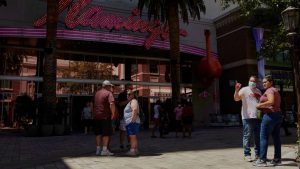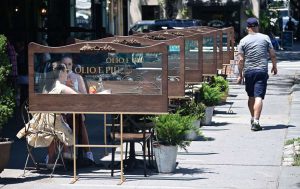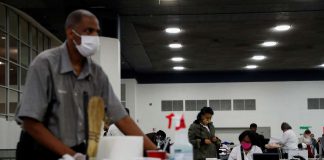JUNE 22, 2020

Pedestrians made their way past Flamingo Hotel and Casino along the Strip on Monday in Las Vegas.
PITTSBURGH — After months of lockdown in which outbreaks of the coronavirus often centered in nursing homes, prisons and meatpacking plants, the nation is entering a new and uncertain phase of the pandemic. New Covid-19 clusters have been found in a Pentecostal church in Oregon, a strip club in Wisconsin and in every imaginable place in between.
In Baton Rouge, La., at least 100 people tested positive for the virus after visiting bars in the Tigerland nightlife district, popular among Louisiana State University students.
At a Christian summer camp near Colorado Springs, at least 11 employees fell ill just before the season’s opening, leading the camp to cancel overnight stays for the first time in 63 years.
And in Las Vegas, just weeks after casinos reopened, a handful of employees from casinos, restaurants and hotels have tested positive, and frightened workers on Monday begged guests to wear masks in a news conference conducted over video.
The newly emerging clusters — which vary in size from a handful of cases to hundreds and have cropped up in large cities as well as small towns — reflect the unpredictable course of the coronavirus. They also underscore risks that experts say are likely to persist as long as states try to reopen economies and Americans venture back into public without a vaccine.
New known virus cases were on the rise in 23 states on Monday as the outlook worsened across much of the nation’s South and West. Hospitalizations for the coronavirus reached their highest levels yet in the pandemic in Arizona and Texas, and Missouri reported its highest single-day case totals over the weekend. Even as much of the Northeast and Midwest continued to see improvement, there were signs of new spread in Ohio, where case numbers have started trending upward after weeks of improvement, and in Pennsylvania, where several counties have had troubling numbers of cases.
“This is exactly what most people would expect when you lift stay-at-home orders and isolation orders,” said Rebecca Christofferson, an infectious-disease expert at Louisiana State University, who said that reopening along with fatigue over social distancing for many Americans were creating new sorts of virus clusters.
“All of those things combined just make it a complex problem — human behavior, contact and virus,” she said. “You put it all in a big pot, and boom!”
It is in some ways a return to the earliest days of the virus in the United States, when the coronavirus was silently brewing, and when occasions like funerals, choir practices and birthday parties became events that led to widespread transmission.
Those kinds of group gatherings were always risks, but they became far less common during a period of months in which much of the country was shut down. The return to public life has brought those opportunities back, as more and more people go shopping, dining, visiting family and friends, and even hugging one another again.

New York City begins Phase Two reopening on June 22, as people can eat outdoors at restaurants and barbershops and salons can also open at 50 percent capacity.
“It really is just all about contact,” Dr. Christofferson said.
The virus is now hitting places that had once escaped the worst of the pandemic, reflecting how a disease that initially ravaged urban centers like New York City has grown more widespread. Known cases now have been on the rise near places like McAllen, Texas; Charleston, S.C.; and Nogales, Ariz.
In Union County, Ore., a rural community of 27,000 about four hours from Portland, officials had recorded only eight cases of the virus by early June. By June 20, the tally had swelled to over 250. Most have been tied to an outbreak at a local church, the Lighthouse Pentecostal Church. “It was a little bit surprising, because so many people for so long were following stay-at-home,” said Paul Anderes, a Union County commissioner.
Houses of worship, which were once shut down under governors’ orders in many states, are now emerging as sources of major clusters. Outbreaks at churches have been reported in states including Alabama, Kansas and West Virginia.
Gov. Jim Justice of West Virginia, a Republican, said that six outbreaks had been linked to churches in the state, including three that were still active as of last week. He said he had no plans to close churches, describing them as “the most sacred ground,” but also acknowledged that they posed a significant danger.
“The reality is really simple,” he said. When congregants do not adhere to wearing masks or sitting every other pew, he said, “we’re asking for it.”
Other vectors for the virus have swiftly emerged in the weeks after many states reopened businesses. At least four cases of the virus were tied to the Cruisin’ Chubbys Gentlemen’s Club in Wisconsin Dells, and several cases were linked to fraternity rush parties in Oxford, Miss.
In Las Vegas, one coronavirus case was reported among workers at The LINQ Hotel + Experience on the Strip. Two more cases were identified among employees at Flamingo Las Vegas Hotel and Casino.
“I am very, very afraid,” said Diana Thomas, a guest room attendant at the Flamingo.
She said that most guests had not been wearing masks, and that she feared bringing the coronavirus home to her son, who is 21 and has asthma.
“I am a single parent,” Ms. Thomas said. “And for me to have my son get sick, no, that’s unacceptable.”
Cases have been on the rise since early June, including after casinos reopened on June 4. In Clark County, which includes Las Vegas, the daily average of new cases has doubled in two weeks, up from 124 to 250 on Sunday. Nevada reported its highest single-day increase in cases last week, at 452 cases.
The uptick comes after officials took steps to safely reopen tourism in a state where many workers depend on the hospitality industry, and a staggering one in four workers reported being unemployed in May. In the newly reopened casinos, dealers and players are separated by clear plastic dividers, and dice are doused in sanitizer after every throw.
“It’s great that the tourists are coming back, but workers need to be safe,” said Florence Lee, who works at MGM Grand casino. “Please wear masks and social distance for us.”
As more segments of the nation reopen, predicting where new clusters will emerge has grown complex. Public health experts are closely watching group gatherings, which threaten to become “super spreader” events, as well as less understood circumstances, in which certain people seem to be more predisposed to transmit the virus.
“The characteristic of this virus — and this is what makes it so difficult to control — is that you do not necessarily have uniform spreading,” said Dr. Arnold S. Monto, a professor of epidemiology at the University of Michigan School of Public Health. “It’s erratic.”
Just as earlier in the pandemic, outbreaks continue to emerge in prisons, nursing homes and food processing facilities. More than 230 people were infected at a Dole vegetable packaging facility in Springfield, Ohio, and at least a dozen cases have been linked to an apple packaging facility in Oswego County, N.Y.
Public health officials in several states have identified coronavirus cases in more than 50 people who attended or worked at protests of police misconduct after the death of George Floyd at the hands of the police in late May. So far, no major outbreaks had been directly linked to those gatherings.
Some of the newest clusters of cases have been tied to athletics, as student athletes return to campus and professional teams hope to play again. At least 23 football players at Clemson University have been infected, along with at least 10 athletes at Iowa State and at least five football players at Texas State. Several professional sports teams, including the Philadelphia Phillies and Tampa Bay Lightning, have also reported cases.
New outbreaks in some cities have overwhelmed hospitals.
Gov. Jay Inslee, a Democrat, warned over the weekend of “a desperate situation for public health” in Central Washington’s Yakima County, where coronavirus cases have spiked, hospitals have reached capacity and patients were being taken to Seattle for medical care.
It echoes an earlier stage of the virus, when Washington State was in crisis mode after it reported the country’s first known case of the coronavirus in January and the country’s first major cluster at a nursing facility near Seattle in February.
After getting the initial outbreak under control, officials saw a resurgence in Yakima County, home to 250,000 people and more than 6,400 coronavirus infections. The situation has now grown dire: The county has more cases than all of South Dakota, and the virus has spread so widely that many Yakima hospital employees are calling off work because they feel ill or are in quarantine.
“We are frankly at the breaking point,” said Mr. Inslee, who planned to require people in the county to begin wearing face coverings in public. “We don’t want to see people in parking lots unable to get hospital care. And if we do not act aggressively now, that is what’s going to happen.”
Courtesy/Source: The NY Times

































































































